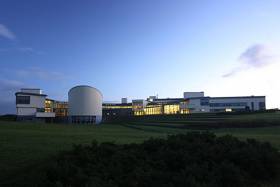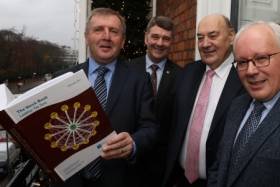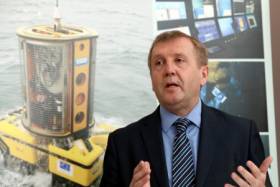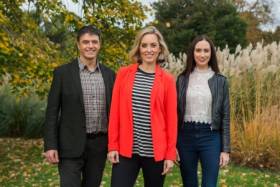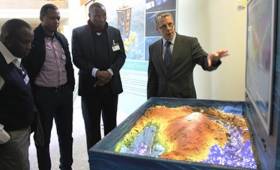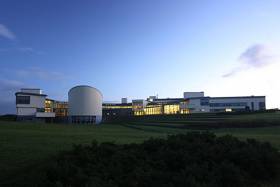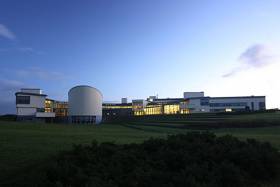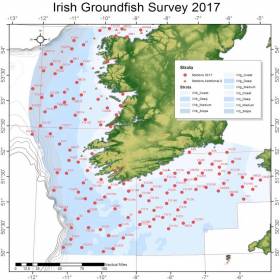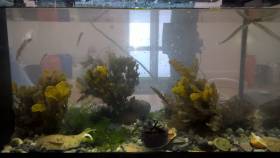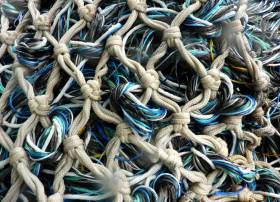Displaying items by tag: Marine Institute
European Association Of Fish Pathologists To Host Third Meeting In Galway Next September
#MarineScience - Following on from the successful conferences in Keele (2014) and Stirling (2016), the Marine Institute in Galway will host the third meeting of the European Association Of Fish Pathologists (EAFP) on 11-12 September 2018.
‘Connecting academia with industry for improved aquatic animal health’ is the theme of next year’s meeting, which will focus on the latest scientific advances and how this can be applied to the crustacean, molluscan and finfish aquaculture industries to improve the health of such marine wildlife.
The meeting will open with a keynote lecture followed by specific sessions on topics relevant to the UK and Ireland. Early stage researchers (post-graduate students, PhDs) will also get the opportunity to present their work in a dedicated session.
Registration for this event will open in early 2018. More announcements will follow on the EAFP website. For queries contact Dr Neil Ruane at [email protected].
Marine Minister Receives Annual Fish Stock Book
#Fishing - Marine Minister today (Tuesday 28 November) received the Marine Institute’s annual Stock Book for 2017.
The Stock Book, one of the principal annual publications of the Marine Institute, provides the latest impartial scientific advice on commercially exploited fish stocks of interest to Ireland.
Provididing the latest scientific advice for 61 fish stocks, the publication is used by the Department of Agriculture, Food and the Marine at the annual quota negotiations with the EU in December of each year and throughout the year at fisheries management meetings.
"The information presented by the Marine Institute in the Stock Book is critical to the preparations for the annual fisheries negotiations which are coming up in the next fortnight,” said Minister Creed.
“The detailed stock-by-stock guide ensures we have the most up to date scientific advice at our finger tips. The fishing industry is a vital part of Ireland's coastal economy, with Ireland’s quotas worth approximately €226 million in 2017.”
Marine Institute chief executive Dr Peter Heffernan added: “The seas around Ireland are among the most productive and biologically sensitive areas in EU waters. Our fisheries scientists spend collectively over 1,000 scientific days each year at sea on the Marine Institute's two research vessels, surveying fish stocks and habitats so that we can have the best available information on the state of our stocks.
“Throughout the year our scientists also participate in and lead ICES working groups on international fish stocks in order to maintain healthy ocean ecosystems and sustain Ireland’s important blue economy.”
Throughout the year the Stock Book also serves as a valuable reference to a wide audience, including the fishing industry, managers, marine scientists, environmental NGOs, third level institutes, financial institutions and those with an interest in the status and management of marine fisheries resources in the waters around Ireland.
The Stock Book is available electronically on the Marine Institute’s website.
Minister Announces Funding For Marine Research Projects
#MarineScience - Marine Minister Michael Creed has announced the awarding of €3.3 million grant funding through the Marine Institute to research projects in specialist marine equipment and ocean law.
Some 19 funding grants in total have been made in the area of specialist marine equipment and small infrastructure, totalling more than €2.5 million.
The Higher Education Institutes (HEI) sector will receive 14 of these grants with five being granted to industry-led proposals (SMEs). The funding grants range from €20,000 to €200,000, with industry being funded at 75 per cent — meaning that these will also leverage private investment in specialist marine equipment for research and innovation development.
The ocean law and marine governance grant is being made to a partnership project between the MaREI Centre and University College of Cork School of Law. The funding amounts to €800,000 and will run over four years, employing three researchers with contributions from 12 MaREI and five UCC School of Law staff.
More than 20 researchers attended the announcement of the grants yesterday (Wednesday 22 November) in Dublin city centre.
“I’m delighted to announce these funding grants which herald the next step forward for many new projects in our marine sector,” said Minister Creed. “The funding for marine research equipment helps to target a gap in funding that exists between supports available to Higher Education Institutes via HEA and support from Ireland’s development agencies such as SFI and Enterprise Ireland.
“These grants will allow the marine research and innovation community to purchase specialist equipment needed to support their current and future research activities.”
Peter Heffernan, CEO of the Marine Institute, said the funding grants would enable pioneering marine research projects to develop in decades to come.
“The ocean law and marine governance grant marks a very important step in investing further in the area of marine law and governance,” he said.
“During the development of the National Marine Research and Innovation Strategy, it was indicated that this important research area should be supported and the Marine Institute, Department of Agriculture, Food and the Marine and the Department of Foreign Affairs were consulted and a call was launched for a project-based funding grant.
“We are delighted that the MaREI Centre and UCC School of Law will be collaborating on this project which is called Navigate and will be led and co-ordinated by Dr Anne Marie O’Hagan, a senior post-doctoral research fellow in the Marine and Coastal Governance Group in the MaREI Centre.”
Irish Weather Buoy Network Features On RTE’s ‘Weather Live’ Tonight
#Weather - The work of the Marine Institute's Irish Weather Buoy Network will feature on RTE One's Weather Live this evening (Friday 17 November).
The TV programme has filmed the redeployment of the M5 weather buoy, which broke free during Storm Ophelia. The show will also feature an interview with the Marine Institute's Dr Guy Westbrook.
A weather buoy has been transported to the Botanic Gardens in Dublin, where Weather Live broadcasts live, so those tuning in can see what one looks like.
The Irish Weather Buoy Network delivers data every hour that is then fed into a global information network which includes Met Éireann, the Irish Meterological Service. This data is then used to inform forecasts as well as long-term information gathering.
Located off the South East coast, the M5 weather buoy captured two records during Ophelia: a record individual wave (Hmax) of 17.81m and a record significant wave height (Hs) of 12.97m.
During the storm, the raging seas caused the M5 mooring to break and the buoy needed to be recovered to shore when the seas had calmed.
Due to the relative importance to forecasters of the M5 weather observing location, it was decided to deploy the M4 target system that had been on test in Killybegs at M5.
This buoy was disassembled and transported by road to Cobh dockyard where it was loaded onto the ILV Granuaile and prepared for subsequent deployment.
Marine Institute staff embarked the vessel on 1 November and deployment of the buoy took place the next day in exceptionally calm conditions.
Weather Live is a three-day television event on RTÉ One that focuses on the fascinating world of weather. It’s presented by Kathryn Thomas and features meteorologists including Evelyn Cusack, Gerald Fleming and Gerry Murphy, and coincides with events for Science Week 2017, as previously reported on Afloat.ie.
The third and final broadcast of the series goes out live this evening Friday 17 November at 7pm on RTE One.
Marine Sector MOU Signed Between Ireland & Kenya
#BlueGrowth - Ireland and Kenya have signed a Memorandum of Understanding towards co-operation of both country’s marine sectors.
The agreement was signed as part of the visit of the Minister for Foreign Affairs and Trade, Simon Coveney, to Kenya and Ethiopia last week.
The MOU between the Marine Institute and the Kenyan Marine Fisheries Research Institute (KMFRI) aims to foster increased understanding and interchange of ideas for the mutual benefit of the Irish and Kenyan marine sectors, and to establish and grow a strong working relationship between the two parties.
“We are very much looking forward to working on areas of co-operation with KMFRI in the coming years,” said Marine Institute chief executive Dr Peter Heffernan. “It is an excellent opportunity for both institutes to share expertise and knowledge.
“We are at an exciting time in terms of marine research, and agreements such as these assist with a sense of collaboration and progress, particularly on an international level.”
A delegation of officials from the Kenyan Ministry of Agriculture, Livestock, Fisheries and the Blue Economy (MALFBE) visited the Marine Institute in February 2016, as previously reported on Afloat.ie.
They were given a broad overview of the work carried out by the institute and the broad range of research vessel surveys that support its work in fisheries and coastal management.
In August 2016, the Irish Embassy in Nairobi invited Dr Paul Connolly, director of fisheries ecosystems advisory services at the Marine Institute, to visit and give a talk on the experience of Ireland with the blue economy and, in particular, the Harnessing Our Ocean Wealth process.
Following on from these and other meetings, a Memorandum of Understanding between the two institutes was proposed and was entered into last week.
Principal areas of co-operation to be pursued under the agreement will initially focus on the following areas of mutual interest:
- Marine fisheries management plans
- Hydro acoustics and assessment of pelagic fisheries resources
- Spatial analyses and mapping of vessel monitoring systems (VMS) data
- Integration of VMS and logbook data for fisheries management
- Data management best practice
- Study visits and exchange of experts
- The establishment of joint PhD and post-doctoral research projects
Minister Coveney’s visit to East Africa also included the launch of a new Kenya-Ireland agri-food strategy, meetings with Irish companies doing business in the region, and the opening of the new Irish Embassy in Nairobi.
Book Your Place For Info Session On Horizon 2020 As Key Investment Driver For Marine Sector
#Horizon2020 - The Irish Support Team for the Atlantic Action Plan, in association with the recently launched Horizon 2020 Work Programme for 2018-2020, will host an information session at the Marine Institute in Oranmore, Co Galway on Tuesday 12 December.
The inclusion of ‘blue growth’ as one of the 12 focus areas for Horizon 2020 represents an important opportunity to build on the marine and maritime sectors of the EU and contribute to the delivery of the Atlantic Action Plan.
The morning session of the event will focus on funding opportunities for the marine and maritime sectors under the new H2020 Work Programme, with NCPs present to highlight the main priorities and funding opportunities. David Murphy (AquaTT) will then lead a practical session on developing a winning H2020 proposal.
After lunch, the focus will switch to marine SMEs. Sean Burke from Enterprise Ireland will address the H2020 SME Instrument, and a member of the Strategic Banking Corporation of Ireland (SBCI) will discuss access to low-cost, long-term finance for marine SMEs.
The day will conclude with breakout sessions with all NCPs present. To pre-book an NCP meeting please e-mail [email protected] before Monday 4 December.
Stakeholders can register online for morning and/or afternoon sessions. Spaces are limited, so please register early to guarantee your place.
Last Chance To Apply For Post-Doc Research Roles With Marine Institute
#Jobs - This Thursday 16 November is the closing date for two post-doctoral research roles with the Marine Institute.
Based at the Marine Institute’s facility in Newport, Co Mayo, the WATexR (Climate JPI) Project requires a post-doc for a period of up to 34 months, who will have a central role in implementing the research project along with the project team.
Meanwhile, at the institute’s headquarters in Oranmore, Co Galway, a data analyst is sought to work on the Co-development of Climate Services for Adaptation to Changing Marine Ecosystems (CoCliME) project.
Applications for both positions close at noon on Thursday 16 November.
Groundfish Survey Off South & West Coasts Ongoing Till December
#MarineNotice - The Marine Institute advises that the annual Irish Groundfish Survey (IGFS2017) is being carried out off the South and West coasts of Ireland till Saturday 9 December in fulfilment of Ireland's Common Fisheries Policy obligations.
The IGFS is a demersal trawl survey consisting of approximately 125 fishing hauls of 30 min duration each in ICES area VIIb, VIIg and VIIj.
Fishing in 2017 is taking place within a two nautical mile radius of these indicative positions, the approximate locations of which are noted in Marine Notice No 55 of 2017.
As with last month's survey off the North West, the operation is being conducted by the RV Celtic Explorer (Callsign EIGB).
The vessel is displaying all appropriate lights and signals during the survey and is also listening on VHF Channel 16. It is towing a high headline GOV 36/47 demersal trawl during fishing operations.
Commercial fishing and other marine operators are requested keep a two nautical mile area around the tow points clear of any gear or apparatus during the survey period.
Learn More About ’Science Of The Sea’ During Science Week 2017
#MarineScience - Science of the sea will be celebrated by the Marine Institute via a number of events taking place during Science Week from Sunday 12 to Sunday 19 November.
The institute will host an interactive stand at the Mayo Science & Technology Open Day on the GMIT campus in Castlebar on Sunday 19 November. Among the exhibits will be two small aquariums where sea creatures can be observed.
The Galway Science & Technology Festival, which is celebrating 20 years of showcasing Galway as a city of science, technology, engineering, art and maths, takes place later in the month on Sunday 26 November.
The Marine Institute will be showcasing its work at the event in NUI Galway and encouraging everyone to learn more about marine science.
As part of Science Week, RTÉ is airing a three-day live television event all about the weather.
Amongst the topics covered, Weather Live on RTÉ One at 7pm next Wednesday, Thursday and Friday will feature the recent Hurricane Ophelia.
The Marine Institute has been working with the programme makers on this item, as it includes the record wave detected by the M5 weather buoy during the storm nearly a month ago.
Elsewhere, Galway Atlantaquaria is hosting a new exhibit ‘Our Ocean, Our Health – Observe, Enjoy and Explore the Digital Ocean’ that features a live feed from the SmartBay Subsea Observatory in Spiddal, Co Galway.
The ocean observatory is supported by the Marine Institute and gives viewers a unique insight into what is happening in real time beneath the sea.
Science Week 2017 is set to be the biggest yet and is part of Science Foundation Ireland’s work in promoting the potential that science and discovery offer Ireland, today and in tomorrow’s world.
Meetings On Changes To National At-Sea Catch Sampling Programme Next Weekend
#Fishing - All interested vessel owners, skippers, crew and fishing industry professionals are invited to attend a series of nationwide meetings on the National At-Sea Catch Sampling Programme.
Emerald Marine, on behalf of the Marine Institute, will be hosting a number of informal meet-and-greets at various locations around the country over the weekend of 17-19 November to discuss recent developments to the National At-Sea Catch Sampling Programme.
Following changes to the European Data Collection Multi-Annual Plan, the Marine Institute is adopting a new statistically sound approach to the National At-Sea Catch Sampling Programme. The framework specifies the data collection to support implementation of the Common Fisheries Policy.
Emerald Marine Environmental Consultancy has been contracted to co-ordinate the new-look catch sampling programme, and has been doing so since July thus year. The Emerald Marine team has been contacting skippers and vessel owners to arrange catch sampling trips and coordinating the available samplers.
Emerald Marine's aim is to complete as many high quality sampling trips as is possible by maintaining good communication and working relationships with vessels, owners, skippers, POs and samplers.
Meetings are scheduled as follows (tea and coffee provided after each meeting):
- Friday 17 November, 12pm-2pm: Tara Hotel, Killybegs
- Friday 17 November, 7pm-9pm: Connaught Hotel, Galway
- Saturday 18 November, 12pm-2pm: Marine Hotel, Howth
- Saturday 18 November, 7pm-9pm: Three Sisters, Dunmore East
- Sunday 19 November, 2pm-4pm: Bera Hotel, Castletownbere
For more details contact Emerald Marine at [email protected] or by phone at 087 151 3541 or 087 145 5599.


























